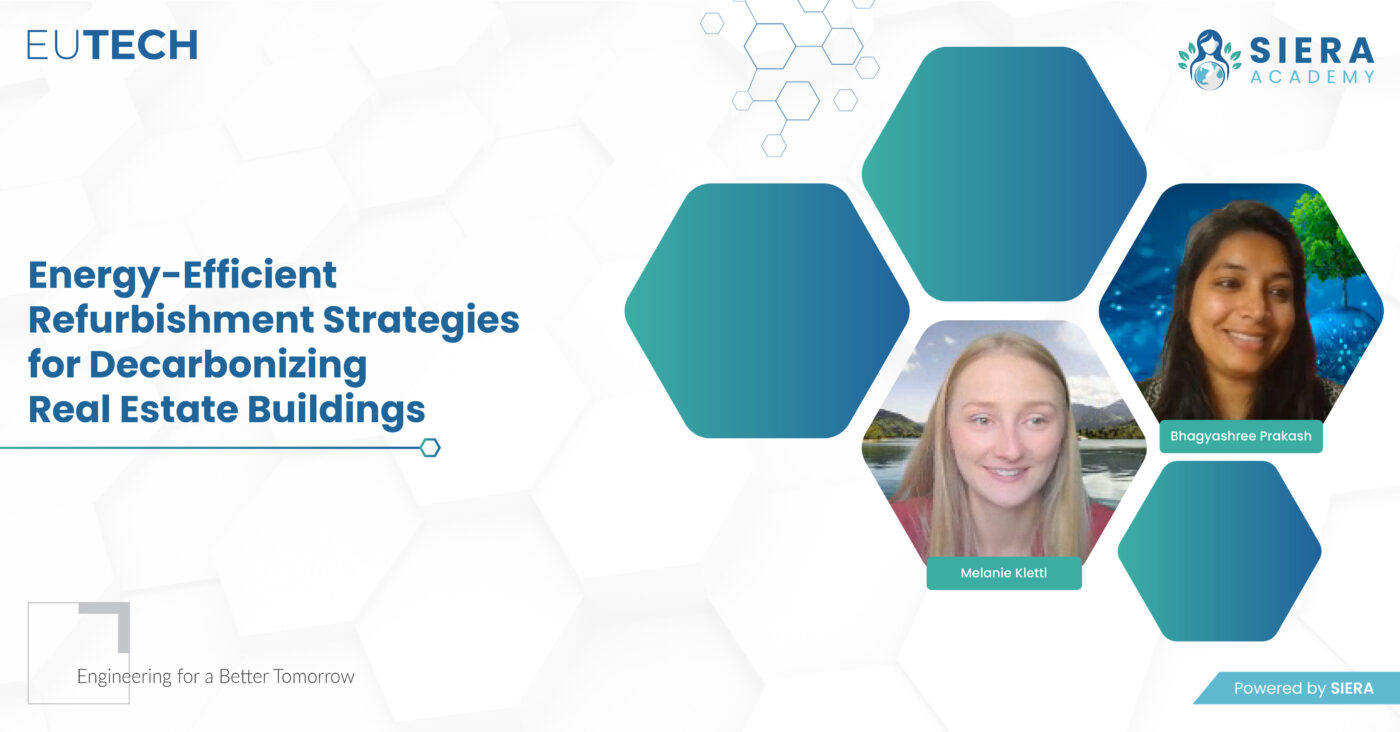The SIERA Impact Webinars are designed to translate complex sustainability requirements into actionable strategies for industry leaders. On August 12, 2025, the focus was on Energy-Efficient Refurbishment Strategies for Decarbonizing Real Estate Buildings—a pressing topic given that buildings are responsible for approximately 40% of total energy consumption and 36% of greenhouse gas emissions in the EU.
With the real estate sector under increasing pressure to meet zero-emission targets by 2050, the webinar examined how comprehensive refurbishment programs—combining deep energy renovations, building envelope optimization, integration of renewable energy, and smart energy management—can significantly reduce operational carbon footprints. These strategies are not just environmental imperatives; they are also business opportunities for increasing asset value, reducing lifecycle costs, and ensuring long-term regulatory compliance.
The discussion was framed within the evolving policy landscape, including the Energy Performance of Buildings Directive (EPBD), Corporate Sustainability Reporting Directive (CSRD), and European Green Deal, which together set ambitious benchmarks for energy efficiency, carbon reduction, and sustainability disclosure. Participants gained insights into the technical, financial, and strategic dimensions of refurbishment projects, learning how targeted interventions can transform existing building stock into future-ready, low-carbon assets.
In this blog, we will explore the key challenges, regulatory implications, opportunities, and solutions for implementing energy-efficient refurbishment strategies—providing a clear, actionable roadmap for organizations aiming to align their real estate portfolios with decarbonization targets and emerging EU regulations.
Challenges – Energy-Efficient Refurbishment
Energy-efficient refurbishment of real estate buildings is a crucial step toward decarbonization, yet it faces a set of interlinked challenges that slow progress and increase costs. One of the most pressing issues is the high upfront investment required for deep retrofits. Even though long-term savings in energy costs are significant, the initial capital expenditure can be a barrier—particularly for SMEs and private property owners with limited access to financing.
Another major challenge lies in the complexity of retrofitting existing building stock. Older buildings often come with structural limitations, outdated materials, and non-standard layouts, making it difficult to integrate modern energy-efficient technologies without extensive redesign and construction. In many cases, the refurbishment process uncovers hidden defects—such as poor insulation, outdated wiring, or inefficient heating systems—that increase project scope and cost.
Regulatory compliance adds another layer of difficulty. Fragmented legal frameworks across regions, combined with evolving EU energy efficiency targets, create uncertainty for property owners and developers. Navigating these requirements demands technical expertise and detailed documentation, which smaller stakeholders often lack.
Finally, there is a shortage of skilled professionals in energy-efficient refurbishment. From energy auditors to specialized contractors, the labour market struggles to meet growing demand. This talent gap not only delays projects but can also compromise the quality of retrofits, reducing the expected energy performance improvements.
Regulatory Implications – Energy-Efficient Refurbishment
The shift toward decarbonizing the building sector in Europe is being driven by one of the EU’s most significant policy updates—the Energy Performance of Buildings Directive (2024/1275). This updated directive sets the stage for transformative change by introducing the most ambitious energy performance requirements to date. Drawing inspiration from the Kyoto Protocol, it combines environmental commitments with binding emission reduction targets, ensuring that energy-efficient refurbishment is no longer optional but a regulatory and business imperative.
| Key Area | Details |
| Legislative Foundation | Energy Performance of Buildings Directive (2024/1275), the EU’s main legislative instrument for improving building energy performance. Inspired by the Kyoto Protocol, setting binding emission reduction targets. |
| Ambition Level | 2024 revision is the most ambitious yet, with a clear roadmap for decarbonizing the building sector. |
| Zero-Emission Standards | By 2030, all new EU buildings must meet mandatory zero-emission performance levels – integrating renewable energy, advanced insulation, and efficient systems from the start. |
| Deep Renovation | Existing buildings must undergo transformative upgrades to achieve zero-emission by 2050. This involves major changes to structural, envelope, and system-level elements. |
| MEPS Implementation | Minimum Energy Performance Standards focus on worst-performing buildings first, progressively raising efficiency until all meet requirements. Ensures a phased transition, aligned with CSRD reporting. |
| Planning & Compliance | Refurbishment projects must align with timelines, performance targets, and be well-documented for sustainability disclosures. |
| Key Message | Energy-efficient refurbishment is a regulatory necessity and a critical business priority—not just an environmental choice. |
Opportunities – Energy-Efficient Refurbishment
- Long-Term Operational Cost Savings – Advanced insulation, renewable energy integration, and high-performance HVAC systems significantly reduce energy use, leading to lower utility bills and improved building value. Savings can offset initial investment over time.
- Enhanced Market Appeal – Buildings that meet or exceed performance standards can secure higher rental income, attract sustainability-focused tenants, and ensure long-term occupancy. Such assets are increasingly prioritized by ESG-driven investors.
- Regulatory Advantage – Early compliance with zero-emission and MEPS standards reduces future retrofit costs, mitigates risks of non-compliance penalties, and positions owners as industry leaders in sustainability.
- Access to Funding and Incentives – EU and national programs often offer subsidies, tax breaks, and low-interest financing for energy-efficient upgrades, lowering the capital burden and encouraging project adoption.
- Positive Corporate Reputation – Demonstrating commitment to decarbonization strengthens brand image, supports ESG reporting goals, and appeals to stakeholders prioritizing sustainable business practices.
Solutions – Energy-Efficient Refurbishment
A successful energy-efficient refurbishment strategy doesn’t just focus on technical upgrades — it integrates financial, analytical, and sustainability-focused services that make implementation feasible, measurable, and compliant with evolving EU climate regulations. SIERA plays a key role here by providing advanced tools and expert services that enable real estate stakeholders to plan, execute, and track decarbonization effectively.
1. Green Financial Advisory Services
We offer targeted guidance on securing funding for refurbishment projects through green bonds, sustainable investment funds, and other ESG-aligned financing instruments. This ensures that property owners can access competitive financing options while meeting sustainability criteria, making even large-scale deep renovations financially viable.
2. Assessment for Energy and Sustainability
Using SIERA’s advanced assessment tools, building performance, materials, and technical systems are thoroughly evaluated to pinpoint specific areas for improvement. This data-driven approach ensures that investments are directed toward the most impactful efficiency upgrades, maximizing energy savings and enhancing building value.
3. Carbon Footprint Assessment
SIERA enables accurate measurement of both direct and indirect greenhouse gas emissions across the building’s lifecycle, using internationally recognized methodologies such as the GHG Protocol and ISO 14064. This forms the basis for transparent reporting and compliance with CSRD and EU climate policy requirements.
4. Carbon Footprint Reduction Strategies
Beyond measurement, we support the development and implementation of tailored carbon reduction strategies. These include upgrading to low-carbon materials, improving operational efficiency, and integrating renewable energy — ensuring a measurable decrease in emissions while maintaining regulatory compliance.
Take the Next Step with SIERA
The SIERA Impact Webinar on energy-efficient refurbishment highlighted a critical reality: upgrading existing buildings for optimal energy performance is no longer a matter of choice—it is a strategic imperative for climate neutrality, cost efficiency, and regulatory compliance. From achieving deep energy retrofits to aligning with EU sustainability directives, such projects demand integrated planning, precise energy data, and effective stakeholder collaboration.
SIERA Alliance equips municipalities, developers, housing associations, and SMEs with the technical expertise, digital solutions, and strategic guidance needed to transform aging buildings into high-performance, low-carbon assets ready for the future.
Our Solutions and Services for Energy-Efficient Refurbishment
- Green Financial Advisory Services with SustainSuite – part of SIERA: Access tailored guidance on securing green bonds, sustainable investment funds, and ESG-aligned financing options that make large-scale refurbishments financially viable while meeting sustainability goals.
- Comprehensive Energy and Sustainability Assessments: Conduct a detailed evaluation of building performance, materials, and systems to identify the most impactful efficiency upgrades—optimizing both costs and energy savings.
- Carbon Footprint Assessment and Reduction Strategies: Measure greenhouse gas emissions using recognized standards like the GHG Protocol and ISO 14064, then implement targeted emission reduction measures that ensure compliance with EU climate policy.
- Alignment with EU Energy Performance and Renovation Standards: Navigate complex regulatory frameworks such as the Energy Performance of Buildings Directive (EPBD) and Renovation Wave targets with confidence, translating them into actionable, measurable refurbishment steps.
- Audit-Ready, Transparent Project Reporting: Leverage SustainSuite’s automated reporting features to produce structured, verifiable documentation for regulators, funding bodies, and stakeholders—backed by clear KPIs and progress tracking.
- Stakeholder Engagement and Capacity Building: Facilitate collaboration between property owners, municipal authorities, financiers, and technical experts through workshops, training programs, and project coordination sessions that keep refurbishment initiatives on track.
Engineering for a Better Tomorrow
Whether you are planning your first building energy audit or launching a portfolio-wide refurbishment program, SIERA Alliance is your trusted partner for scalable, compliant, and high-impact energy efficiency projects. Together, we can transform today’s buildings into the sustainable infrastructure of tomorrow. Contact us today to make your refurbishment vision a reality.









